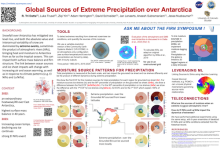Ocean Sources of Extreme Precipitation over Antarctica
Rajashree
Datta
Atmospheric and Oceanic Sciences Department, University of Colorado, Boulder
Poster
Extreme precipitation over Antarctica is a strong control for both total precipitation and interannual variability and is, by extension, a major source of uncertainty in future sea level rise estimates. This is illustrated by a record surface mass balance year in 2022, driven largely by two major extreme events, in this case, atmospheric rivers (ARs). Here, we use model outputs over the 1990-2015 period to quantify ocean moisture sources of extreme precipitation events (EPEs), including ARs . We employ a new variable-resolution grid over Antarctica, using CESM2 (VR-CESM2), which has the extensibility of a GCM but with less computational costs then a global high-resolution climate model. This setup uses observed sea surface temperature and sea ice concentration, implements moisture-tagging (linking precipitation to a moisture source region on the globe), and produces high spatial and temporal resolution atmosphere and ice sheet surface outputs. In addition to this baseline, we will conduct small-ensemble experiments to assess the relative impact on extreme events of reduced sea ice combined with enhanced ocean heat at lower latitudes.

datta-rajashree-polar-poster.pdf
(1.75 MB)
